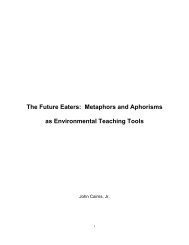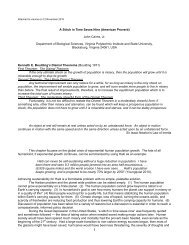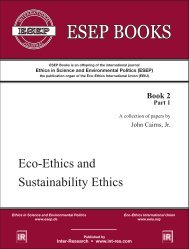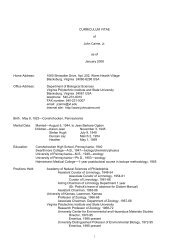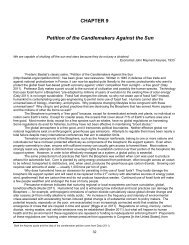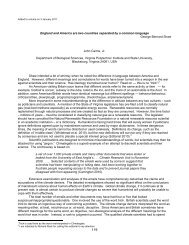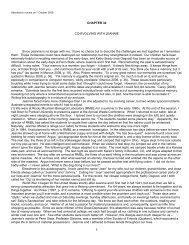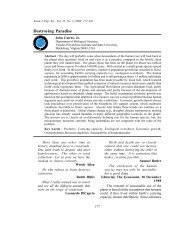288Article 35Reproduced with permission from the Panthenon Publishing Group LtdInt. J. Sustain. Dev. World Ecol. 11 (2004) 36–47Eco-ethical Issues: Self-regulating Versus SubsidizedEcosystemsJohn Cairns, Jr.Department of Biology, Virginia Polytechnic Institute and State University, Blacksburg, Virginia 24061, USA.KEY WORDS: Sustainability · Eco-ethics · Subsidized ecosystems · Self-regulating ecosystemsSUMMARYSustainable use of the planet requires dependable delivery of ecosystem services at a level necessaryto meet the needs of humankind. During the last two centuries, particularly in the twentiethcentury, ecosystems have been fragmented and stressed in a variety of ways, including bioticimpoverishment. Self-regulating ecosystems are capable of maintaining nominative structure andfunction, including normal variability. Those ecosystems incapable of self regulation will requiresubsidies, which will divert resources from other activities that may also be important to sustainableuse of the planet. If ecosystems are not subsidized, the loss of natural capital and ecosystemservices will almost certainly impair the quest for sustainable use of the planet. Although most discussionsof sustainability reflect an awareness of humankind’s dependence on natural systems,ecosystem self regulation has not received an adequate amount of attention.SELF-REGULATING ECOSYSTEMSSelf-regulating ecosystems should not be thought of as only technological systems. Regulatemeans to direct or control by means of a principle. Self regulation in nature is not a conscious effort,but rather the result of resource partitioning in which finite or limited resources are shared by anenormous number of species (30+ million). This distribution means that no single species gets a disproportionateshare of the resources and that the wastes of one species are resources for anotherspecies. This allocation of resources per species is the result of resource partitioning achieved by aprocess of co-evolution by quite dissimilar species. For example, nectar is available in a wide varietyof flowers of quite different structures. Hummingbirds have evolved an array of bill lengths so thateach species is particularly suited to obtain nectar from a flower with a particular structure. As a con-Correspondence: J. Cairns, Jr., Department of Biology, Virginia Polytechnic Institute and State University,Blacksburg, VA 24061, USA
Article 35289sequence, a particular resource, nectar, is partitioned because some species are more suited togathering nectar from certain flowers than others. Species diversity is maintained by conditions thatpermit the survival of substantial numbers of these co-evolutionary relationships. However, if aparticular species of hummingbird disappeared, the nectar would still be available to other nectargathering species less capable of exploiting the resources of a particular flower.Furthermore, evolution is always moving toward increasing complexity, which results in finer andfiner partitioning of resources. Complexity in nature results in an array of feedback loops, interrelationships,and, most important, use and reuse of resources. This dynamic system keeps everything(e.g. nutrients) moving, and species are also constantly being replaced in a successional process.However, species that disappear from one locale usually appear at another one. Despite this activity,the structure and function of the ecosystem remain remarkably stable, although the ecosystemdoes vary within limits. This dynamic stability is maintained by the interaction of an array of rateprocesses. One such interaction that results in an equilibrium number of species has beendescribed by MacArthur and Wilson (1963). Another model of community structure that remainsremarkably constant, although the kinds of species do not, is described by Patrick (1949). Illustrativefunctional attributes are described by Likens and Bormann (1995).Nature favours quantity, from which it selects quality. Individual species and individual organismshave important roles, always in the context of the interdependent web of life in which all species,including humans, are a part. Often overlooked in the quest for sustainability are the changesrequired in the direction of humankind’s financial investments, the orientation of its technology, theallocation of global resources, and, most important, in our mind set. Emulating the processes ofnature is the most direct path to sustainability.Nature ensures that its resource reserves are not readily available on demand. Furthermore, systematicrecycling and reuse protects nature’s inventory of both renewable and nonrenewableresources and keeps them from being pushed beyond critical limits needed for sustainable use.Societal and institutional change must be directed by the ability of natural systems to absorb theeffects of human activities. Humankind is ethically responsible for present unsustainable practicesand also for instituting the changes necessary to achieve sustainability.The concept of viewing natural systems as sacred and inviolate will be a shocking or offensiveidea to many people. Even acknowledging humankind’s dependence upon natural systems will bedifficult for many people. Asserting that both exponential and economic growth are unsustainableon a finite planet will be met by ridicule and sarcasm by those people reaping enormous wealthfrom these practices. However, if humankind lacks the courage and depth of ecological understandingnecessary to eliminate unsustainable practices, nature will do so in ways that will causeboth the wealthy and poor to suffer.Earth is an ecosphere and the evolutionary source and support of life. A committee of the EcologicalSociety of America defined an ecosystem as a spatially explicit unit of Earth that includes allorganisms, along with all components of the abiotic environment within its boundaries (Christensenet al. 1996). The term ecosystem was first used by Tansley (1935), who noted that organisms claimsociety’s primary interest. He also stated that, even when research and thinking are on the basiclevel, organisms cannot be separated from the special environment with which they form one physicalsystem. The National Research Council (1992) states that the goal of restoration is to emulatea natural, functioning, self-regulating (italics mine) system that is integrated into the landscape inwhich it occurs. It is almost platitudinous to state that a damaged ecosystem is not self regulatingand that exemplary ecological restorations have restoring this capability as a major goal. During the



